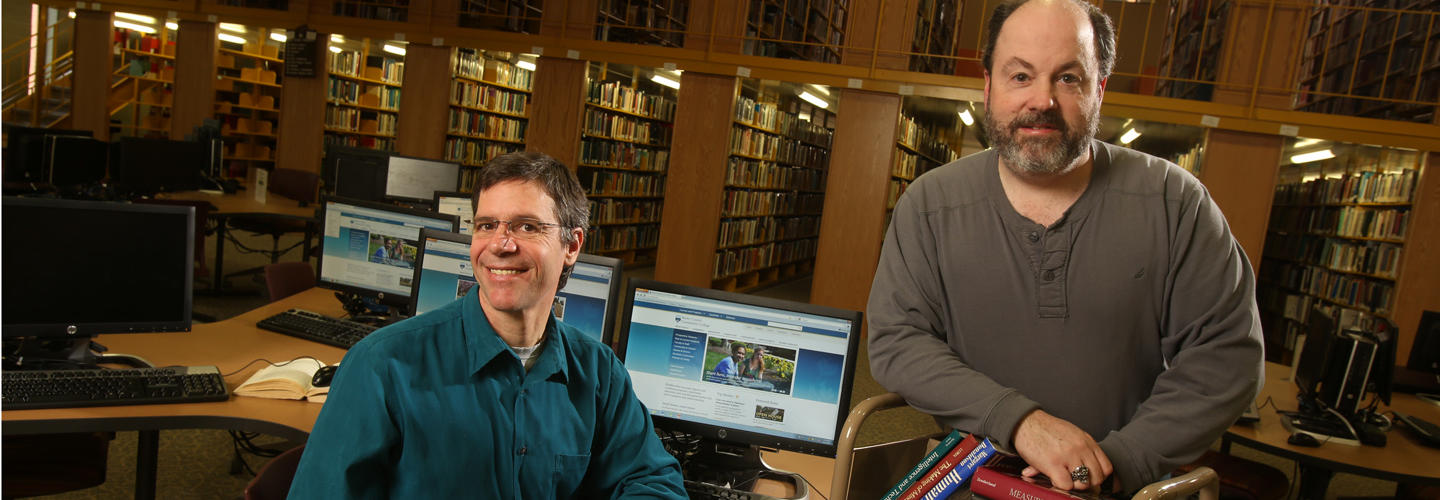College Libraries Transition to High-Tech Learning Centers
The old-fashioned campus library that focused primarily on storing books, journals and periodicals has evolved. In its place: open spaces for collaborative learning, whiteboards for taking notes and sharing ideas, and plenty of technology.
Books are still vitally important, but the many media options available now enhance learning and engage students, many of whom need help from the latest technology to better enjoy reading and writing their own stories.
Ron Smith, director of networking, AV and infrastructure services at Bucks County Community College in Newtown, Pa., says college officials knew that meeting the library's expanding bandwidth requirements was critical to the success of the building's overhaul during the past two years.
"Many students come to campus with four devices today: a cellphone, a tablet, a notebook computer and an MP3 device with a wireless chip," Smith says. "With the library more of a learning [instruction] space now, we knew we had to upgrade the bandwidth to support all the media-rich activities that were being planned."
The number of wireless access points grew from just a handful to a mix of 40 Aruba 135 and 125 APs. The college also deployed an Extreme Networks X450 Gigabit Ethernet switch in the library, which connects to an Extreme BlackDiamond 8900 10 Gig-E switch in the data center. To support the upgraded wireless, the college also deployed an Aruba MMC-6000 controller in its data center, and an Aruba 3600 controller at each of its three remote campuses.
Karl Carter, director of the library's MInDSpace (Media and Instructional Design) media lab, now has the wired and wireless bandwidth he needs to work with students and faculty on media literacy.
"Today's students may be comfortable with the new tools, but that doesn't mean they know how to use them effectively," Carter says. "There's also a tremendous need for the faculty to learn these tools."
Students and faculty come to the media lab to learn how to do timelines on video editing tools such as Microsoft Movie Maker. Collaborative spaces enable students to work on projects together. Carter and his team also work closely with the faculty to support class media assignments.
The library has 50 notebooks for lending, and boasts 48 onsite desktops, four loaded with Adobe Creative Suite. A virtual desktop interface supported by Faronics Deep Freeze lets students securely access a broad range of academic applications.
Kenneth C. Green, founder of The Campus Computing Project, says learning to use all the digital tools offered by modern libraries is an important part of a student's portfolio today.
"The days when an entering college student could afford to pass up the library tour because it was just about books are long gone," Green says.
20,000 The approximate number of times per year the Bucks County (Pa.) Community College library lends notebook computers to students
It's About Media Training
Librarians at the William H. Hannon Library at Loyola Marymount University in Los Angeles have taken the lead in information literacy on campus, but the dean of the library, Kristine Brancolini, wants to expand that role to cover technology literacy as well.
Opened in 2009, the Hannon Library hosts a variety of workshops on the use of research tools, such as Zotero, the citation management software. Data gathered at the library's information desk (through Gimlet software) suggests that students need help with other types of productivity applications as well. Increasingly, students are asking for help with software such as Adobe Photoshop, Excel and the video editing software available on the library's Information Commons computers.
The university's Faculty Innovation Center, located at the Hannon Library and staffed by instructional technology analysts, provides a place for faculty to experiment with new teaching and research technologies. Brancolini plans to extend the service to students, and is now looking for a location within the library where a similar "technology sandbox" can be hosted.
"The overabundance of information in the digital age places further importance on the library's role as a facilitator and guide," says Tara Radniecki, Loyola Marymount's new emerging technologies librarian. "Providing access is not enough. Libraries must make that information meaningful and instill information literacy skills, which will be crucial to their success in both the university and their later careers."
The Turnaround Artist
A few years ago, the DeLaMare Science & Engineering Library at the University of Nevada, Reno, had maybe five to 10 visitors at any given time each day. Dr. Tod Colegrove, head of the library, says that number is now about 150 students — and even faculty members are returning.
The reason? Colegrove transformed the library into a modern, collaborative learning environment — beginning with relocating the library's print periodicals and journals to a storage and retrieval facility in the main campus library, which opened up nearly 18,000 square feet in DeLaMare.
The new space left room for the science library to increase the number of computers, from 39 to 130. Special whiteboard paint was applied to the walls, which students now use to take notes and exchange ideas. Tables were set up to allow science and engineering students to tinker with analog controllers, electronics kits, and soldering irons and crimpers.
With the installation of a 3D printer and scanner, DeLaMare became the first academic library in the nation to offer that technology to all students and the community. Another important change: Staff members were moved to a central area on the main floor where they are visible and available to answer questions. "The window of opportunity when a student's ready to learn is only open for a short time," Colegrove says. "Now we're ready."








